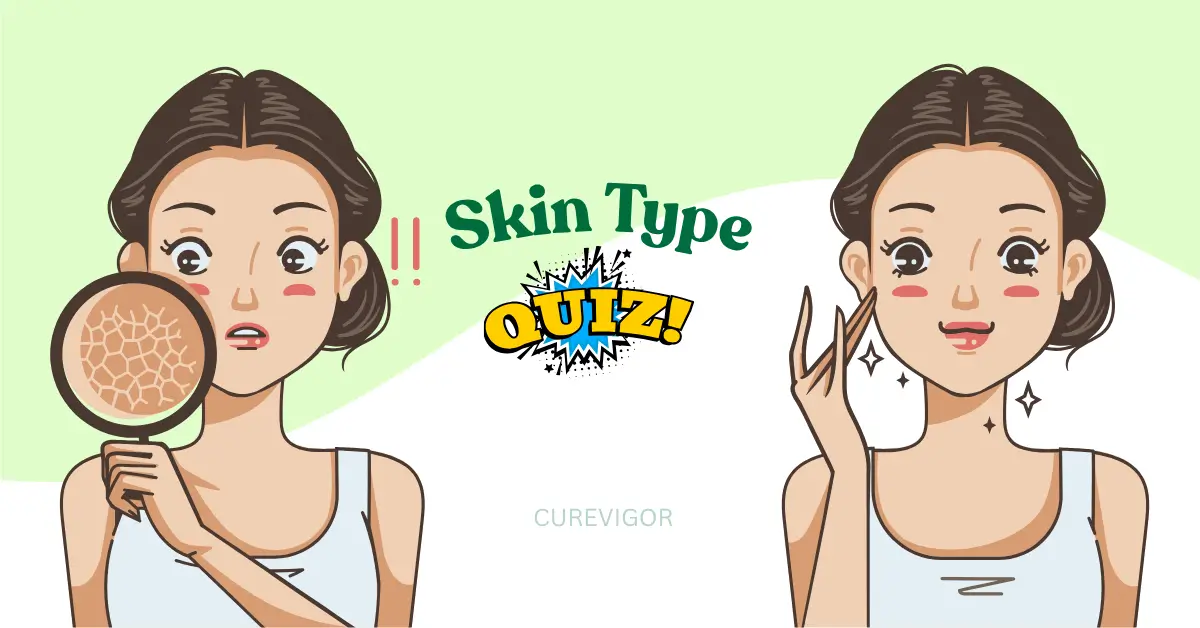Stop guessing! Take the ultimate skin type quiz to instantly identify your unique needs. Get personalized ingredient advice and unlock your best skincare routine now.
Thank you for reading this post, don't forget to subscribe!How to Use a Skin Type Quiz to Find Your Perfect Routine
You’ve read the articles, you’ve tried the cleansers, and you’ve invested in the serums—but are you seeing the results you want? If your skincare routine feels like a frustrating game of trial and error, it’s probably because you’re skipping the most crucial step: truly understanding your unique skin type through this skin type quiz.
Generic routines fail because they treat all skin uniformly. Dry skin requires intense hydration and barrier support, while oily skin needs regulation and gentle, yet consistent, exfoliation. If you confuse the two, you may exacerbate your current skin problems.

Ready to cut through the confusion and find the customized routine that’s been waiting for you?
Grab a pen and paper—or just your phone’s notepad—and let’s discover your skin’s true identity with the ultimate Skin Type Quiz.
The Bare-Face Test: How to Take Skin Type Quiz Accurately
For the most accurate results, you need to see your skin in its natural, unadulterated state. Follow these steps 60 minutes before you start the quiz:
- Cleanse: Gently wash your face with a pH-balanced cleanser and pat it dry.
- Wait: Do NOT apply any serums, moisturizers, oils, or makeup. Wait 30 to 60 minutes.
- Observe: Your skin’s natural tendencies will become visible during this time. Now you can answer the 10 questions below with total honesty.
Your Skin Type Quiz: Answer Key
For each of the 10 questions below, choose the answer that best describes your skin most of the time. Keep track of which letter (A, B, C, or D) you choose for each question.
1. Immediately after washing your face, your skin feels:
A. Tight, uncomfortable, and maybe even a little itchy.
B. Clean, comfortable, and balanced—neither dry nor greasy.
C. Tight in some areas (cheeks) but fine in others (forehead/nose).
D. Already slick or quickly returns to feeling oily and shiny.
2. Mid-day (around 2 PM), your skin’s appearance is:
A. Dull and slightly flaky or powdery.
B. Smooth and healthy, maybe with a slight glow.
C. Shiny in the T-Zone (forehead, nose, chin), but matte on the cheeks.
D. Very shiny all over, often blurring your makeup (if you wear any).
3. How visible are your pores?
A. Nearly invisible or extremely small.
B. Small and noticeable only up close.
C. Noticeably larger in the T-Zone, but small on the cheeks.
D. Large and easily visible all over your face, especially on your nose.
4. How often do you experience breakouts (pimples or spots)?
A. Rarely, but occasionally, I get a patch of redness or irritation.
B. Rarely, one small spot every few months.
C. Occasionally in the T-Zone, particularly around the time of my cycle.
D. Frequently, with multiple active spots and noticeable blackheads/whiteheads.
5. How does your skin react to rich, heavy moisturizers?
A. My skin drinks it up! It feels nourished and relieved.
B. They feel nice, but sometimes they can feel a little too heavy.
C. They feel great on my dry areas (cheeks), but cause oiliness or breakouts on my T-Zone.
D. They usually feel heavy, suffocating, and cause me to break out.
6. When exposed to heat or harsh weather (wind, cold), your skin tends to:
A. Turn red, get chapped, and become extremely irritated or sensitive.
B. Handle it well, perhaps a little dry in the winter.
C. Experience changes only in the drier parts of my face.
D. Get even oilier, sometimes leading to more shine and breakouts.
7. How often do you need to use blotting papers or touch-up powder?
A. Never.
B. Rarely, primarily for special occasions.
C. Once or twice a day, targeting my forehead and nose.
D. Multiple times throughout the day to manage excess oil.
8. The fine lines/wrinkles on my face are most noticeable when:
A. My skin is feeling dehydrated or tight.
B. Only when I make expressions.
C. They aren’t a primary concern yet.
D. They appear less visible due to the natural oil content of my skin.
9. When trying new products, your skin:
A. Often reacts with stinging, redness, or a rash.
B. Is generally happy and rarely reacts negatively.
C. Sometimes reacts to heavy ingredients in certain areas.
D. Rarely reacts to new products, though it might break out if the product is too pore-clogging.
10. How does your skin feel in the morning when you wake up?
A. Dry, thirsty, and sometimes tight.
B. Supple and smooth.
C. A little oily around the nose, but fine everywhere else.
D. Quite oily and noticeably shiny.
Calculate Your Results of Your Skin Type Quiz!
To determine your unique skin profile, we’ve assigned points to each answer based on the level of oil production and sensitivity:
| Answer | Point Value |
| A | 1 Point (Indicates Dryness/Sensitivity) |
| B | 2 Points (Indicates Balance/Normalcy) |
| C | 3 Points (Indicates Combination/Partial Oiliness) |
| D | 4 Points (Indicates Oiliness/Acne-Proneness) |
Add up all your points for the 10 questions to get your total score.
Your Total Score of Skin Type Quiz is:
\____\_
Your Personalized Skin Guide: Detailed Results
Find your score range below to get a detailed breakdown of your skin type, the ingredients you should seek, and the common mistakes you need to avoid!
10 – 16 Points: A: Dry & Sensitive Skin
Key Characteristics
Your skin lacks sebum (natural oil), which means your protective barrier is often compromised. This leads to moisture loss (dehydration) and leaves your skin vulnerable to irritants, resulting in redness, flakiness, tightness, and a dull, chapped appearance. Dry skin is an oil issue; dehydration is a water issue—and you often have both!
Your Action Plan: Hydrate and Protect the Barrier
| Focus Ingredients | Avoid Ingredients | Routine Mistake to Fix |
| Ceramides: To repair the skin barrier. | Foaming Cleansers: They strip natural oils and exacerbate dryness. | Hot Water: Always cleanse and rinse with cool or lukewarm water to prevent capillary damage and moisture loss. |
| Hyaluronic Acid: To draw water into the skin. | Harsh Physical Scrubs: They cause micro-tears and worsen sensitivity. | Skipping SPF: Dry skin is already fragile; use a mineral-based SPF daily to protect it. |
| Squalane/Rich Oils: To seal in moisture and mimic natural sebum. | High Concentrations of Alcohol/Fragrance: They cause immediate redness and stinging. | Over-Exfoliation: Limit gentle chemical exfoliation (such as lactic acid) to once or twice a week, at most. |
17 – 24 Points: B: Normal & Balanced Skin
Key Characteristics
This is the most balanced skin type. Your sebaceous glands produce just enough oil to keep your skin supple and protected, without making it shiny. Your pores are small, breakouts are rare, and your skin rarely reacts negatively to new products or environmental stress. Your primary goal is to maintain this balance and focus on prevention.
Your Action Plan: Maintenance and Prevention
| Focus Ingredients | Avoid Ingredients | Routine Mistake to Fix |
| Antioxidants (Vitamin C, E): For daytime environmental protection. | Overly Heavy Occlusives: Thick balms can feel unnecessary and may cause minor congestion. | Getting Complacent: Just because your skin is easy doesn’t mean you can skip cleansing before bed or forget SPF. |
| Gentle Retinoids: For long-term collagen production and anti-aging benefits. | Excessive layering: Keep your routine simple and effective; you don’t need 10 steps. | Ignoring the Neck/Chest: Extend your preventative routine (moisturizer and SPF) to these areas! |
| Niacinamide: To keep pores clear and skin texture even. | Using Products for Other Skin Types: Avoid harsh acne treatments or extremely heavy creams unless they are specifically recommended for your skin type. | Physical Exfoliation: Use gentle chemical exfoliation (like glycolic acid) 2-3 times a week instead of aggressive scrubbing. |
25 – 33 Points: C: Combination Skin
Key Characteristics
Combination skin is characterized by duality: an oily, shiny T-zone (forehead, nose, and chin) with visible pores, and normal or dry U-zones (cheeks and jawline) with smaller pores. This means you need a hybrid approach where different areas of your face are treated differently.
Your Action Plan: Balance and Targeted Treatment
| Focus Ingredients | Avoid Ingredients | Routine Mistake to Fix |
| Niacinamide: Excellent for balancing oil production in the T-Zone without drying the cheeks. | One-Size-Fits-All Moisturizers: A thick, rich cream for your cheeks will clog your T-Zone. | Over-Cleansing the T-Zone: Using harsh cleansers to dry out the oily areas causes them to produce more oil. |
| Lightweight Serums: Layering thin, water-based products that can be applied all over the face. | Heavy Face Oils: Avoid using these on areas other than your dry cheeks. | Not Multi-Masking: Use a clay mask on your T-Zone and a hydrating sheet mask on your cheeks simultaneously. |
| Salicylic Acid (BHA): Applied only to the T-Zone to dissolve oil deep inside the pores. | Using Acne Treatment All Over: Products formulated for oily skin can irritate and dry out your U-Zone (cheeks). | Forgetting Your Cheeks: The dry areas need just as much attention as the oily ones—use a richer cream there at night. |
34 – 40 Points: D: Oily & Acne-Prone Skin
Key Characteristics
Your skin produces excess sebum, leading to a constant shiny appearance, enlarged pores, and a higher propensity for congestion (blackheads and whiteheads). While this oil makes your skin resilient and less prone to fine lines, it requires careful management to prevent constant breakouts.
Your Action Plan: Oil Control and Clarification
| Focus Ingredients | Avoid Ingredients | Routine Mistake to Fix |
| Salicylic Acid (BHA): The gold standard for dissolving sebum and dead skin cells inside the pores. | Alcohols (like SD Alcohol or Denatured Alcohol): These cause initial dryness but trigger rebound oil production. | Skipping Moisturizer: Oily skin needs hydration, not oil. Use a lightweight, oil-free gel or water cream to prevent dehydration. |
| Clay (Kaolin, Bentonite): For weekly masks to absorb excess surface oil and purify pores. | Pore-Clogging Heavy Oils: Ingredients such as coconut oil or mineral oil can be too heavy for acne-prone skin. | Too Much Scrubbing: Avoid harsh brushes or physical scrubs that spread bacteria and cause inflammation. |
| Retinoids/Retinol: To regulate cell turnover and keep pores functioning optimally (a key step for all skin types, but crucial here). | Using Soap: Traditional bar soaps are often too alkaline and can disrupt the skin’s pH balance, leading to additional issues. | Touching Your Face: Keep Your Hands Off! Bacteria and oil transfer easily, leading to more breakouts. |
Conclusion on the Skin Type Quiz to Find Your Perfect Routine
Now that you have a definitive, detailed understanding of your skin type by skin type quiz, the confusing part of skincare is officially over. You no longer have to waste money on products that aren’t formulated for your unique needs.
Instead of guessing, you have a personalized guide that covers exactly which ingredients to embrace and which common mistakes to correct immediately.
Click on your personalized “Next Step” link above to explore the exact daily routine and ingredient recommendations specifically tailored to your skin type. We’ve got the whole morning and evening breakdown waiting for you.
Get more Health & Beauty Tips.
You might love:

